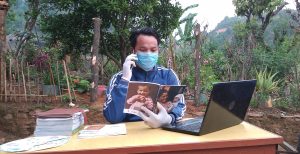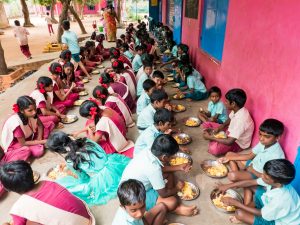Adapting a large multi-sectoral nutrition program during the COVID-19 pandemic: The story of Suaahara II from Nepal
Nepal, as a country, has faced several humanitarian crises. Five years after one of the most destructive earthquakes in the recent history, the country is once again at the brink of facing disruptions arising with COVID-19 lockdowns. In this blog, we hear from the team leading the second phase of Nepal’s multi-sectoral nutrition program, Suaahara, funded by the U.S. Agency for International Development. They share their experiences of how the program has adapted to not only ensure continuity in provision of its own services to women and young children, but also assist the national emergency response. – Samuel Scott, series co-editor and Research Fellow at IFPRI.

Sagar Hiski, a Suaahara II field staff counselling 1000-day household members via telephone in Nepal’s western Palpa district. When the government enforced the nationwide lockdown, Suaahara II field staff moved to tele-counseling instead of in-person household visits. (Photo Credit: Himal Hiski )
As COVID-19 emerged as a global threat, countries acted swiftly to impose lockdowns and mobility restrictions. The government of Nepal’s decision to impose a nation-wide lockdown on March 24 caught the whole country by surprise and brought everything to a standstill. Development programs too bore the brunt of the lockdowns.
The Suaahara II program
The Suaahara II “Good Nutrition” Program, funded by the U.S. Agency for International Development (USAID), and implemented by a team of local and international partners led by Helen Keller International, reaches approximately two million households that cut across half the geographical area of Nepal. Suaahara II is dedicated to improving the health and nutritional well-being of mothers and children in the 1000-day period from conception until a child reaches 24 months of age. Partner non-governmental organizations (PNGOs) mobilize more than 1,500 field staff who deliver the program’s integrated package of interventions that promote optimal health, nutrition and hygiene practices, improve access to diverse and nutrient-rich foods, strengthen health services, and support implementation of nutrition policies through multi-sectoral platforms and systems. The field staff provides interpersonal counseling through home visits, and conducts community events including cooking and hand-washing demonstrations, the celebration of key-life events like new pregnancies and births and radio discussion groups. The local PNGO staff work closely with local government officials from district, municipal and ward levels.
Adapting to COVID-19 needs
As the program had a strong field presence, USAID responded to the rising number of COVID-19 cases with emergency funding to allow the program to support the government’s preparedness and response plans. The restriction on mobility, however, meant that field staff were locked at home when their communities needed them the most. To support the field staff in this new context, Suaahara II swiftly coordinated with the government to develop messages on COVID-19 infection control and infant and young child feeding that were shared with field staff via social media and cloud platforms.
From April to June, Suaahara II field staff were able to transition from in-person to remote and mobile-based interpersonal counseling. They counseled a total of 1.15 million families via phone, including 400,000 within the first 1000-day period. They provided additional guidance on:
- the availability of government relief packages at the municipality level
- ways to safely continue agricultural work
- sharing household chores to reduce work burdens on women
- helplines established for reporting domestic violence and abuse
- techniques for maintaining mental health, and where and how to seek psycho-social support when needed.
These key messages were reinforced through other communication channels. For example, field supervisors sent a total of 3.8 million messages (SMS) that were specifically tailored for households with pregnant woman or a child under two years. Suaahara II’s weekly radio show included 11 new COVID-19 related episodes, which were aired through 120 local FM radio stations. Interviews and briefings with experts were produced and disseminated via social media. These interviews explained the importance of physical distancing, COVID-19 testing methods, recognizing symptoms of common psycho-social problems related to the pandemic, reintegrating returning migrant workers and individuals recovered from COVID-19 into communities, do’s and don’ts in quarantine, and the government’s plans and policies to manage threats to household food insecurity. The radio program and social media initiatives also provided opportunities to the public to raise queries and receive answers to their concerns to expose and dispel any kind of rumors.
In addition, phone calls were made to households at-risk, linking them with appropriate support systems, including health care, quarantine centers, food relief, or treatment for children suffering from acute malnutrition. More than 50,000 food insecure families were able to access government food relief packages. Field staff also helped 2,100 health facilities to identify and address bottlenecks in basic health and nutrition services and supplies to ensure the continuation of essential services.
Suaahara II field staff coordinated with a total of 31,000 municipal authorities across the 389 targeted municipalities, as well as other stakeholders supporting the treatment of COVID-19 infected persons and protection of those at risk of infection. The program earned praise from government counterparts at the federal, provincial and local levels for its success in coordinating, collaborating with and supporting the government’s efforts. At the request of provincial governments, the program recruited clinicians to support the management and treatment of COVID-19 as well as lab technicians to speed up COVID-19 testing and case identification.
Flexibility of the program that allowed for quick adaptability
Suaahara II‘s ability to adapt to the new conditions reflects the capacity, flexibility and reach of the program prior to the pandemic. The program’s database contains demographic information including mobile phone numbers of almost all 1.9 million households residing in its implementation areas. Given this, field staff were able to prioritize 1000-day families for mobile-based counseling and support and identify specific sub-population for targeted SMS messages. For example, mothers of young children received an SMS to assure them that it is safe to continue breastfeeding even if they have symptoms or a diagnosis of COVID-19.
With restrictions still in place, but slowly easing in certain areas of the country, the government rolled out a modified version of its national Vitamin A and deworming distribution program in early July. Suaahara II supported procurement and distribution of protective equipment for the 27,000+ female community health volunteers who led the distribution of the modified services at the community level. The field staff also called thousands of households to ensure their uptake of this service and, where possible, provided on-site support during distribution to reinforce infection prevention and protective measures such as safe distancing of those waiting in line.
Challenges and way forward
Staff safety has remained the greatest challenge over the last three months, and risks are expected to increase in the coming days. The government has started zoning districts by number of active cases, as green (<50), yellow (51-200) and red (>200), allowing certain activities in green and yellow districts. In line with government directives, Helen Keller International is rolling out a plan to ensure that staff safety is not jeopardized while performing critical activities in their designated communities.
Rumors arising from the pandemic have posed significant challenges to Suaahara II’s communication work. This “infodemic” is being managed by creating a continuous feedback loop linking people in communities, districts and the national capital. An open, easy and diverse communication channel, this system allows anyone to ask questions, and help to continuously update job-aids and communication materials.
Managing expectations of support from various tiers of the government has also been a challenge. Suaahara II has designated one staff member to coordinate with the respective provincial governments and municipalities and keep them informed of the program’s efforts. The program has expanded beyond its regular scope to support the transportation of essential health and nutrition supplies, procure and supply personal protective equipment to female community health volunteers, and provide additional staffing in provincial health directorates and testing labs.
This crisis will certainly aggravate food insecurity in the country. Suaahara II has begun discussions with government and external development partners to identify the most-at-risk areas to better target emergency support. There is clearly no one-size-fits-all solution in overcoming the COVID-19 pandemic.
While continuing to support the government’s priorities at all levels, Suaahara II will also build on the learnings of the past few months to best serve the population affected by the COVID-19 pandemic. These include maintaining open, two-way communications between civil society and national experts to ensure updated information is available and understood, managing linkages to essential and emergency services including safety-net access and psycho-social support, especially to the poorest and most vulnerable, and promoting functional food systems and livelihood opportunities to bolster food security.
As activities resume in Nepal, government’s adaptive capacity to create new norms, resourcefulness of civil society, and the technical assistance made available through Suaahara II and its outreach, together, will carve a pathway to recovery.
Pooja Pandey Rana is Deputy Chief of Party, Suaahara II Program, Helen Keller International, Nepal. Indra Dhoj Kshetri is the Outreach Communication Manager, Suaahara II Program, Helen Keller International, Nepal. The analysis and opinions expressed in this piece are solely those of the authors.
This blog has been published as a part of the International Food Policy Research Institute (IFPRI), South Asia, blog series on analyzing the impacts of the COVID-19’s pandemic on the sub-national, national, and regional food and nutrition security, poverty, and development. To read the complete blog series click here
New research from a Special Issue of Applied Economic Perspectives and Policy
The pandemic caused disruptions to both the supply of and demand for health services that persisted past the lifting of lockdown measures.
Public food transfer programs have traditionally been the most common social protection programs in Bangladesh


